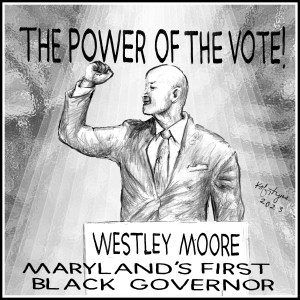By Sam McKenzie
Back in September of last year, I interviewed for a position in state government under the Hogan administration. When I made my way to the waiting area, I looked up and saw a picture of the then-current Governor Larry Hogan, and Lieutenant Governor Boyd Rutherford.
As I stood there looking at his photo in a state building, I wondered if I could work in his administration given my political views. As you would expect, Hogan’s photo was slightly higher up, and Rutherford’s was beneath Hogan’s.
We’ve seen that same photo arrangement a few times in Maryland’s history. We saw it with Ehrlich and Steele, and we saw it with O’Malley and Brown. It’s been a winning combo for Democrats and Republicans alike in Maryland.
That photo arrangement is also a picture of a racist and gendered hierarchy in Maryland.
With the election of Wes Moore, Maryland’s first Black governor, voters break ranks with part of that pattern. Today, a Black man’s photo is first and slightly higher. I imagine the spirits of many Black voters are slightly higher today too, and rightfully so. The partial break from the previous photo arrangement is significant for all Marylanders and the nation.
In the opening of his bestseller, “Faces at the Bottom of the Well,” the late Derrick Bell wrote, “Even the poorest Whites, who must live their lives only a few levels above, gain their self-esteem by gazing down on us.”
We see there that White racism calms its nerves by having Black faces even slightly lower than itself. But for the next four years, White racism will have to look up at Governor Wes Moore, too.
The new photos of Governor Wes Moore and Lieutenant Governor Aruna Miller in state buildings are more than symbolic for us. “Can’t you feel a brand new day?” Now, a Black man, born in 1978, like me, is at the helm of the state.
My governor being Black gives him an affinity, authenticity, and likeability with me that no pollster asking about whom I’d like to have a beer with can measure. As a Black man, the same age as Moore, I am walking around these Baltimore streets feeling like I could’ve been or could be governor too.
Finally, someone who may have worn Guess or Cross Colours in the 90s, like me, resides in the Governor’s Mansion. I know my governor at some point in his life had a little fro, and I’m sure he knows all about the Black barbershop experience.
At the same age, we lived through Rodney King, The Malcolm X movie, and the O.J. trial. I’m sure my governor received similar talks about race in America as I did. And I’d like to think my governor and I have similar musical interests, spiritual leanings, and taste buds. In Maryland, state power at the highest level is in Black hands and those Black hands are from my generation.
History shows us that state power is not just any sort of power. State power is the kind of power that can make or break you.
The brilliant sociologist Tressie McMillan Cottom tells us about the making done by state power when she writes that “Whiteness can only be defined by state power. It requires a legal system that can formalize irrational biological expressions, making them rational.
It needs a justice system that will adjudicate the arbitrary inclusion and exclusion of people across time. And, most of all, Whiteness requires a police state that can use violent force to defend its sovereignty.”
State power is always consequential. It’s never neutral. It matters whether state power works for you or against you.
Steve Martinot, in his book, “The Machinery of Whiteness,” tells us about the breaking done by state power with these words, “Domination is always a social relation whose existence requires a state for its continuance. Without a state, the subjugated walk away and find autonomous modes of existence for themselves.”
With all the celebration and connection, we also know that state power in Black hands is not necessarily or automatically empowering for Black people. I shouldn’t have to name names. You already know.
In the past, the call for “Black power” wasn’t a call for any type of Black power. We must assess the plans and intentions of those sitting in the seat of state power. Fortunately, Moore has told us how he plans to use state power. His campaign slogan was “leave no one behind” and he spoke about “work, wages, and wealth.”
There’s no doubt that if Moore enacts his agenda, Black people will benefit. However, I am concerned it will not be enough for deep needs. I’m concerned that our first Black governor did not run a campaign that spoke directly to where Black Marylanders are located.
“Leave no one behind” resonated with voters. I asked my mom why she voted for Wes Moore, and she said, “His campaign slogan caught my attention. There are so many people who have been left behind for decades.”
That comes from a woman whose B.S. detector is next level. She always knew when I was lying, musty, or didn’t wash my hands. Her political judgment is no less sound. Like my mom, I understand the origins, the sentiment, and the use of “Leave no one behind.” It works as a generalized and humane creed.
But “leave no one behind” is not adequate as the philosophical framework for an administration that seeks productive and enduring change. Former President George W. Bush gave us a policy with a similar ring to it, “No Child Left Behind.” Some critics today call “No Child Left Behind” a policy failure.
Maybe part of the problem with “No Child Left Behind” wasn’t the sentiment but the angle it took. Moore’s “Leave no one behind” suggests some sort of horizontal arrangement that Black Marylanders don’t have or enjoy. Like the Lieutenant Governor photos, Black Marylanders aren’t behind, we are beneath.
We are under helicopters, blue lights, and street cameras. We are underfunded and under-resourced. We are under dilapidated roofs and undervalued homes. We are under siege from bullets and inflation. We are underemployed and underpaid. We are under arrest, and we are under ineffective leadership that only gets us more of the same.
Being “beneath” or “under” is not the same as “being left behind.” Someone who is “behind” needs to catch up. Someone who is “beneath” needs what’s above and on them to get off them. How you see it will determine your approach.
A “behind” approach seeks programs and assistance. A “beneath” approach seeks justice and transformation. A “behind” approach may close gaps slightly and slowly. A “beneath” approach is going to bust up and rearrange the state’s affairs as soon as possible. One is a remedial treatment– the other is a revolutionary undertaking.
Moore has said a few times that Maryland is “asset rich but strategy poor.” As a type of strategy, because my mom likes it, “leave no one behind” can be the public face. But behind closed doors, we need a different strategy. The difference between behind and beneath must be clear inside the Moore Administration.
Behind closed doors, let the Moore strategy be closer to Frantz Fanon’s interpretation of “the last shall be first, and the first shall be last.” I hope behind closed doors Moore’s strategy echoes Reverend Al’s, “Get your knees off our necks!”
In other words, I need my governor– who is Black– to be an antiracist, too. Undoubtedly, Moore understands that many Marylanders are ahead and on top of us because of White racism. I do not think it is too much to hope that the person who broke that history may also be interested to right that history.
The goal is not to catch up with the spoiled and spoils of White racism. We need the justice that is owed for being on top of us. It is the difference between “let me help you” (behind) and “let me get this out of your way (beneath).”
Based on his work history, Moore has done a good deal of “let me help you” work. Prior to becoming governor, Moore was CEO of the nonprofit, Robin Hood Foundation. Maryland’s nonprofits should have an ally in Moore for programs, funding, and support.
Like Moore, I have a history of working with nonprofits. I have been in the industry of helping people for over 20 years. I hope Moore has learned, like me, that nonprofit programs cannot do and should not do what only the state can do. Nonprofits do not have state power.
In fact, many nonprofits exist because the state refuses to do what it should do. Nonprofit programs cannot fundamentally fix what state policies royally wrecked. No one should expect a nonprofit to end the social problems it depends on for funding. So, while we need job training programs and everything else the state has to offer, Black Marylanders are also entitled to cash reparations.
The days of operating an Underground Railroad where many, but not all, get free are over. We need full emancipation once-and-for-all in the form of cash reparations. And it is troubling to me that Moore’s stance on reparations is unclear.
During a gubernatorial debate when asked about reparations, Moore did not say the word itself. Why not? I’m tired of reading between the lines and hoping for the best. The questions about reparations are not going away. There is no question there. But whether Maryland will soon serve as pudding full of proof is an outstanding question.
I hope Moore does not leave us to the pace and pulse of Annapolis. We need executive advocacy and executive action on reparations. Will Moore create a commission to disburse reparations like the governor of California or not? I hope he does, but it’s unclear.
I also find Moore’s “work, wages, and wealth” to come from the same place as “leave no one behind.”
The alliteration of “work, wages, and wealth” can serve as a roadmap. Fix the work. Fix the wages. People get wealthy. Great. It’s a politically effective three-word phrase that takes one from work to wealth.
However, history messes with generic idealism: Black Marylanders shouldn’t have to work. Work for Black Marylanders should not be necessary for survival. Isn’t that how capitalism and generational wealth work?
For the beneficiaries of capitalism and generational wealth, work is optional. It should be the same for the recipients of generational deprivation and oppression. Instead of waiting and wading through work and wages, the people skipped over should now be skipping to the bank and the wealth part. Just as Moore is a newcomer to politics, many of us want to be newcomers to wealth.
That’s why if Democratic control of Annapolis doesn’t yield reparations this time, it will be a shame and a disgrace again. Only this time, my governor is Black.
Like Moore, I used to live in Montgomery County. I know Maryland to be a rich state overall. And now as a Baltimorean, I need Annapolis to know that if Maryland’s largest city is not transformed by this administration, it will be a Democratic failure again. Only this time– my governor is Black.
We need Maryland’s money to spread around the state and only cash reparations can do it. Maryland Democrats have no excuse for not getting it right this time. And this time, my governor is Black.
I know that my governor being Black is not enough by itself. Over time, Moore’s policies and his use of power will matter more.
Politicians often form policies and use power based on their position in society. Position, they say, determines your perspective. While Moore’s race is a major change in the position, his gender is not. I can’t help but wonder what it would be like to write about my governor being a Black woman.
I know one thing; Black women are at the forefront of reparations in America. A Black woman leads the reparations effort in Congress. A Black woman leads the reparations effort in Illinois. A Black woman leads the reparations effort in California. And a Black woman in Maryland, Del. Wanika Fisher, is leading the reparations charge here.
It is from Black women like Fisher that we get such clear statements like, “This (reparations) bill’s attempt is to address the cancer — to address the illness of the core — which is systematic racism in the form of slavery that has put the black diaspora in an economic, political and social disadvantage for far too long.”
I want to see more Black progressive governors across America. I want to celebrate all those firsts while asking for more because we don’t just need more Black progressives as governors, we need Black women who are progressives as governors. The base of the Democratic Party deserves to reach the party’s pinnacles. Unless and until Black women become governors, gubernatorial politics is a bit of a farce.
For Moore, gubernatorial politics is a serious business venture that could lead to the White House. Like many governors before him, Moore could turn this into a presidential run. I hope he does. Democrats desperately need political talent. And Moore could be the one.
But if Moore decides to go easy on race-related issues, because he wants to go big politically, let’s hold him accountable. Moore has made history. He’s writing his track record now. While I am thrilled that my governor is Black and has a family photo that looks like the one I grew up in, that’s not enough by any means.
But for the first time ever, in the history of the state, it’s a start. It’s an excellent start.
Sam McKenzie is a freelance writer who lives in Baltimore City with his partner and two dogs.
The opinions on this page are those of the writers and not necessarily those of the AFRO. Send letters to The Afro-American • 233 E. Redwood Street Suite 600G
Baltimore, MD 21202 or fax to 1-877-570-9297 or e-mail to editor@afro.com
Help us Continue to tell OUR Story and join the AFRO family as a member –subscribers are now members! Join here!
The post Commentary: My governor is Black appeared first on AFRO American Newspapers .











